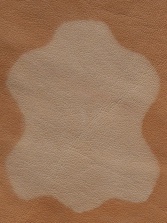Colour fastness - Light fastness of leather
Contents
Light fastness of leather
Fading is one of the main causes of damage to leather objects, apart from damages caused by sweat and body grease, mechanical stress and ageing.
The light fastness of a material describes its resistance to fading by light, in particular by the constant radiation of UV light. Among the types of leather, aniline-coloured porous leather is especially at risk of losing its original hue. The more engineered pigmented leather is less prone to this phenomenon.
Aniline leather day 0, day 16 and day 50 in sunlight.
Faded, embossed nubuck in comparison with the original pattern.
The light fastness of leather - as well as with textiles - is measured by means of the so-called blue scale. In doing so, eight blue wool strips of descending light fastness are placed together with a sample of the leather to be tested in ultraviolet light. A part of the sample surface and a part of the wool strip surface is covered and compared after the exposure. The degrees of light fastness are expressed as follows:
| Degree | Designation | Corresponds in Central Europe an exposure time of |
|---|---|---|
| 8 | outstanding | 700 days |
| 7 | excellent | 350 days |
| 6 | very good | 160 days |
| 5 | good | 80 days |
| 4 | pretty good | 40 days |
| 3 | moderate | 20 days |
| 2 | low | 10 days |
| 1 | very low | 5 days |
For leather, grade 6 is already referred to as light resistant, since it fades faster than textiles. Aniline leather must have a grade of at least 3 or 4.
Xenon test
In the laboratory, there are devices that measure the fading sensitivity. Widely used is the xenon test, which attempts to simulate sunlight.
The xenon test shows the fading sensitivity. The fading on the grain side is easily recognisable.
Influence variables on fading sensitivity
The following parameters influence the fading sensitivity:
- The sensitivity to fading is not due to the leather, but to the dye.
- Not all dyes fade easily. Two different black or red tones can behave completely differently. Reliability about the fading sensitivity can be provided by comparison tests. The sensitivity to light influences is checked with the xenon test.
- The more leather colour is applied onto leather, the better is the light fastness. Unfortunately, strong colour application affects the haptic of leather.
- For leathers dyed in the same shade, the fading sensitivity is lower.
- UV-protective lacquers improve the fading behaviour of leather.
- The fading behaviour of suede, nubuck and aniline leather is the same.
- The fading behaviour of textiles with identical dyes is significantly better due to the improved fixability of the dyes in textiles.
Aniline leather covered in the middle after 2.5 months in the window.
The following illustrations demonstrate the effects that UV light can have on the appearance of an insufficiently protected leather. The examples show aniline, suede and nubuck.
Vegetable-tanned leather
The dye in aniline leather or the pigment-based coatings on finished leather fade, causing the surface to become lighter. In the case of uncoloured vegetable-tanned leather, it behaves differently. The leather darkens by light. And the darkness can fade with time. This effect is probably related to fats and oils in the leather.
Vegetable-tanned leather day 0, day 16 and day 50 in sunlight.
The darkening of vegetable-tanned leather is a desired patina and belongs to the ageing of this type of leather. Care must be taken to ensure that the patina is uniform and does not become unpleasant as a result of unilateral light conditions or local soiling and stains.
Darkened, vegetable-tanned, natural (uncoloured) smooth leather.
Additional information



























 a kotori web solution
a kotori web solution